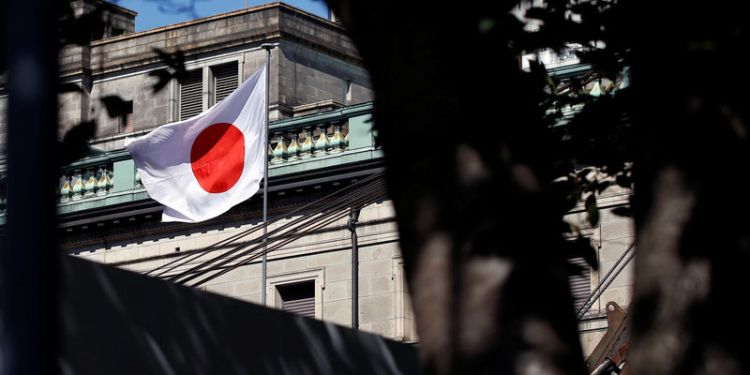 © Reuters. A Japanese flag flutters atop the Bank of Japan building under construction in Tokyo
© Reuters. A Japanese flag flutters atop the Bank of Japan building under construction in TokyoBy Tetsushi Kajimoto and Daniel Leussink
TOKYO (Reuters) – The Bank of Japan cut its inflation forecasts and stuck to its ultra-loose monetary policy on Wednesday, as pressure on the economy mounts and slowing global demand threatens its years-long efforts to foster durable growth.
The deteriorating global outlook means the BOJ is some way off from exiting a sweeping stimulus program begun in 2013, which policymakers have acknowledged will do more harm than good the longer it is retained.
The central bank maintained its view that Japan’s economy, the world’s third largest, will continue to expand at a modest pace. Yet the rising pressure on global growth from a trade war between the United States and China – Japan’s biggest trading partners – has many analysts wary about the outlook.
“Japan’s economy is likely to continue on an expanding trend through fiscal 2020,” the central bank said in its quarterly outlook report.
“Overseas economies are expected to continue growing firmly on the whole, although various developments of late warrant attention such as the trade friction between the United States and China.”
A Reuters poll of economists showed those external factors have increased the chances of Japan sliding into a recession this coming fiscal year starting in April, making it ever so harder for the BOJ to reach its 2 percent inflation target.
Moreover, the International Monetary Fund (IMF) trimmed its global growth forecasts and a survey showed increasing pessimism among business chiefs amid the trade tensions.
At its policy-setting meeting ending on Wednesday, the BOJ kept its short-term interest rate target at minus 0.1 percent and a pledge to guide 10-year government bond yields around zero percent.
With stubbornly weak inflation forcing it to retain its massive stimulus longer than expected, the BOJ took steps in July to make some changes to its policy framework, such as allowing bond yields to move more flexibly around its target.
On Wednesday, the BOJ’s nine-member board issued a quarterly report analyzing Japan’s economy including fresh growth and inflation projections through the fiscal year ending in March 2021.
The central bank cut its economic growth projections in the current fiscal year to March, but it raised its growth forecasts slightly in the fiscal years 2019 and 2020, with government spending seen to offset the pain of the planned tax hike in October.
In a further sign of the tough road ahead, government data out on Wednesday showed Japan’s exports in December fell the most in two years.
LOWER INFLATION FORECAST
The BOJ cut its forecast for core consumer inflation to 0.9 percent in the fiscal year beginning in April from 1.4 percent, reflecting slumping oil prices and the potential fallout from slowing global growth. It was the fourth downward revision by the central bank to its inflation forecast for fiscal 2019 since it was first estimated in April 2017.
That was still above a 0.7 percent forecast by analysts polled by Reuters.
The central bank also trimmed core consumer inflation in fiscal 2020 to 1.4 percent, from 1.5 percent forecast in October.
Many economists in the poll say the BOJ’s next move is to start normalizing policy, with its steps likely including expanding its 10-year bond yield fluctuation from 0.2 percent and raising the 10-year yield target from around zero percent.
A majority expect that would happen in 2020 or later.
As part of efforts to prevent financial institutions from sitting on their huge pile of cash, the central bank decided to extend the deadline by one year for lending schemes aimed at encouraging financial institutions to boost loans and support growth foundations .
The BOJ’s radical stimulus program has had some unintended consequences, as years of low rates hurt financial institutions’ profits.
Many BOJ policymakers are wary of ramping up stimulus, though external shocks or a sudden spike in the yen could force the central bank to do just that if the economy is at risk of sliding into recession.
Source: Investing.com



























